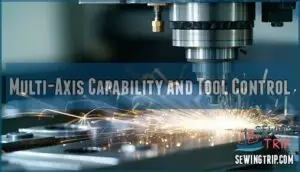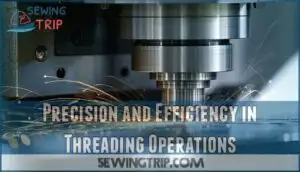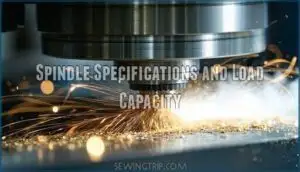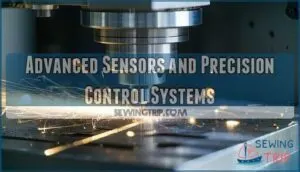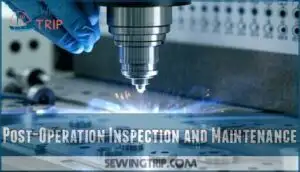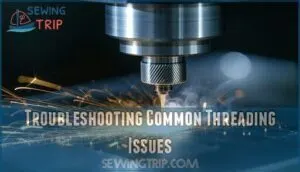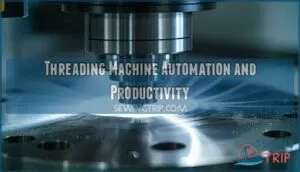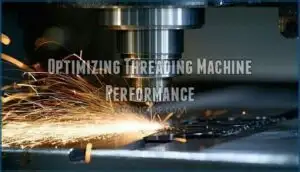This site is supported by our readers. We may earn a commission, at no cost to you, if you purchase through links.
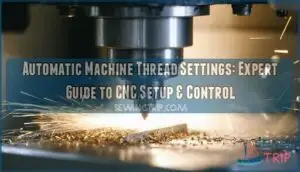
These settings work together like a synchronized orchestra—your spindle speed, feed rate, and tool positioning must align perfectly for clean, precise threads.
Modern CNC systems automatically calculate these parameters based on your thread specifications, but understanding the relationship between pitch, diameter, and cutting forces gives you real control over the process.
The secret lies in how these automated systems balance speed with precision, and there’s more to optimizing this balance than most operators realize, which is key to a successful CNC threading operation.
Table Of Contents
Key Takeaways
- You’ll achieve consistent thread quality by letting automatic systems calculate spindle speed, feed rate, and tool positioning based on your thread specifications, eliminating guesswork and manual adjustments.
- Your threading precision depends on balancing speed with accuracy – modern CNC systems automatically optimize cutting forces and parameters, but understanding this relationship gives you real control over the process.
- You can maximize efficiency through automatic threading cycles and preset modes that handle tool changes, performance monitoring, and parameter adjustments with minimal operator intervention.
- You’ll prevent costly breakdowns by maintaining regular lubrication schedules, component inspections, and preventive maintenance rather than waiting for reactive repairs.
Automatic Machine Thread Settings
You’ll find automatic machine thread settings transform your CNC threading operations by eliminating guesswork and manual adjustments.
These computerized systems use sensors and preset parameters to automatically control thread pitch, spindle speed, and feed rates, ensuring consistent results every time, with consistent results being the key outcome of this process.
Threading Machine Components and Features
Your threading machine’s Chuck Design secures workpieces with precision-ground surfaces, while Die Head Materials like carbide inserts handle various thread standards.
Carriage Mechanisms on ball bearings guarantee smooth movement during operations. Coolant Systems manage heat buildup effectively, extending tool life substantially.
Motor Efficiency affects your threading pitch adjustment accuracy through the control panel. These threading machine components work together seamlessly when you select the appropriate threading mode for automatic machine settings.
The machine’s overall performance is optimized with proper threading machine maintenance and setup, ensuring a smooth operation and extended tool life with proper maintenance and optimized performance.
CNC Threading Machine Specifications
When selecting automatic CNC threading machines, you’ll encounter specifications that directly impact your project’s success.
Thread Geometry control supports various profiles, while Axis Movement ranges from 3 to 5 axes for precise Tool Control.
Spindle Specs include bore diameters from 130-255mm and speeds up to 720rpm.
Machine Dimensions accommodate workpieces with swings over bed reaching 1000mm, ensuring your threading operations meet exact requirements, with precise Tool Control being crucial for the task.
Threading Pitch and Machine Setup
Machine Calibration begins with precise pitch control settings that determine your thread’s geometry.
You’ll adjust spindle speed and feed rates to match your target specifications, ensuring Setup Optimization for consistent results.
Understanding the impact of thread pitch selection is vital for achieving superior machine performance.
- Thread Accuracy verification – Use pitch gauges and micrometers to confirm your CNC thread grinding machine produces exact measurements.
- Automatic threading cycle programming – Input pitch values through the control panel, double-checking entries against project requirements.
- Threading pitch verification – Perform test cuts on sample material before running full production batches.
- Machine setup documentation – Record successful parameters for future threading operations and quality control.
Common Threading Methods and Techniques
You’ll encounter five primary threading methods when working with CNC machines.
Thread cutting uses single-point tools on lathes for precision work, while tapping creates internal threads with specialized threading tools.
Thread milling employs rotating cutters in the die head for complex profiles.
Thread grinding delivers exceptional surface finish for critical pipe fitting applications.
Die-cutting pushes workpieces through dies for external threads.
Each method requires specific machine calibration and threading pitch verification to guarantee your automatic threading cycle delivers consistent results throughout the threading process to ensure consistent results.
Key Features of Automatic CNC Threading Machines
You’ll find that automatic CNC threading machines combine multi-axis capability with advanced sensors to deliver precise thread control across complex geometries.
Modern CNC threading machines merge multi-axis precision with smart sensors for flawless thread control.
These systems integrate tool change orchestration, high-capacity spindles, and real-time monitoring to maximize efficiency while maintaining consistent thread quality.
Multi-Axis Capability and Tool Control
Modern CNC threading machines leverage multi-axis capability to control tool movement with surgical precision.
You’ll find these systems orchestrate complex tool changes automatically, moving cutting tools through multiple axes simultaneously.
CNC lathes and thread milling operations benefit from automatic tool changers that position dies exactly where needed, transforming threading from guesswork into predictable, repeatable operations.
The use of multi axis systems enables advanced machining capabilities, making the process more efficient and accurate with surgical precision.
Precision and Efficiency in Threading Operations
Within today’s precision threading landscape, automatic CNC threading machines deliver exceptional Thread Quality through advanced Machine Calibration systems.
These systems maintain threading precision while ensuring Operational Safety during high-volume production.
Smart Material Selection algorithms optimize Efficiency Metrics, enabling precision threading that consistently meets tight tolerances.
Your threading guide benefits from real-time adjustments that enhance overall productivity.
Spindle Specifications and Load Capacity
Your spindle specifications directly impact threading capabilities and workpiece handling.
CNC threading machines offer spindle speeds ranging from 30 to 720 rpm with variable frequency control, while bore diameter variations span 130mm to 255mm.
Load capacity limits reach up to 4 tons for heavy workpieces, and axes of movement from 3 to 5 provide precise tool control for thread geometry control across different profiles.
For peak performance, choosing the right CNC Threading Machines that match your specific threading needs is vital.
Advanced Sensors and Precision Control Systems
Advanced sensors and precision control systems transform automatic CNC threading machines into highly accurate manufacturing tools.
Advanced sensors turn CNC threading machines into precision manufacturing powerhouses through intelligent automation.
These integrated systems monitor every aspect of your threading operation, providing real-time feedback that guarantees consistent quality.
Machine learning algorithms analyze performance data to refine cutting parameters automatically, while sensor calibration maintains precision engineering standards throughout production runs.
- Temperature sensors detect thermal variations affecting thread accuracy
- Vibration monitors identify tool wear before quality issues occur
- Force sensors measure cutting loads for ideal tool life
- Position encoders guarantee precise tool positioning within microns
- Data analytics systems track performance metrics for continuous improvement
CNC Threading Machine Operation and Maintenance
You’ll need to master proper operation and maintenance procedures to guarantee your CNC threading machine delivers consistent, high-quality results.
Following systematic pre-operation checks, monitoring techniques, and maintenance protocols will extend your machine’s lifespan and maintain threading precision throughout its operational life.
While minimizing downtime is crucial, it is equally important to ensure that your machine is functioning at optimal levels to produce the desired results.
Pre-Operation Checks and Safety Precautions
Before you start threading, proper preparation keeps you safe and guarantees smooth machine operation.
Always wear Personal Protection equipment including safety glasses, gloves, and ear protection.
Conduct thorough Machine Inspection, checking for damage and verifying all components function correctly.
Clean the threading area completely, then power on and allow warm-up time.
Access the control panel to verify settings and select appropriate threading mode for your project.
Threading Cycle Initiation and Monitoring
Once your pre-operation checks are complete, you’ll initiate the threading cycle using your machine’s Cycle Start Modes. Modern CNC threading machines offer multiple start options including manual, semi-automatic, and fully automatic modes.
Here’s your step-by-step monitoring process:
- Select threading cycle parameters through the control panel interface
- Activate Thread Monitoring Systems to track cutting force and tool wear
- Monitor Real-time Feedback Control displays for spindle synchronization and feed rates
- Watch Automatic Thread Detection sensors verify proper thread formation
- Observe Error Compensation Techniques automatically adjust for thermal expansion and tool deflection
Your threading control system continuously processes data from realtime feedback mechanisms, while automatic tool changers stand ready for seamless handovers. Keep your eyes on the threading monitoring display—it’s your window into the process.
Post-Operation Inspection and Maintenance
Once your threading cycle completes, you’ll need to conduct a thorough Thread Quality Check and thread inspection to verify proper surface finish.
Remove the workpiece carefully and examine thread consistency, then perform Machine Cleaning of cutting dies and work area.
Additionally, regular maintenance of the CNC threading machine is vital to prevent thread damage issues.
Complete your Post-Operation Analysis by documenting results for Performance Review and Maintenance Scheduling to maintain superior threading quality control.
Troubleshooting Common Threading Issues
Identifying threading issues quickly saves time and prevents costly errors.
When your CNC machine starts producing defective threads, systematic troubleshooting gets you back on track.
- Thread Breakage – Check for dull tools, excessive cutting speeds, or inadequate lubrication causing tool failure
- Vibration Issues – Inspect machine stability, tool overhang, and spindle bearing condition for smooth operation
- Inconsistent Threads – Verify threading pitch accuracy through encoder feedback and axis screw wear evaluation
- Misaligned Dies – Examine tool holder alignment and workpiece clamping to guarantee proper thread formation
- Chip Formation – Monitor chip evacuation and cutting parameters to prevent surface finish degradation
Threading Machine Automation and Productivity
You’ll discover that modern CNC threading machines transform productivity through intelligent automation that handles complex threading operations with minimal operator intervention.
These systems coordinate automatic cycles, tool changes, and performance monitoring to deliver consistent results while freeing you to focus on higher-level production planning with minimal operator intervention.
Automatic Threading Cycle and Preset Cycles
Modern CNC threading machines transform complex operations into streamlined processes through automatic threading cycles and preset modes.
You’ll program specific parameters like thread pitch, depth, and speed into the machine’s memory, creating repeatable cycles that maintain thread precision across multiple workpieces.
These auto settings eliminate manual adjustments between jobs, while preset cycles optimize efficiency by storing common threading specifications for instant recall, ensuring repeatable cycles that improve overall production efficiency.
Tool Change Orchestration and Optimization
Your CNC threading machine’s Tool Management system coordinates seamless shifts between cutting tools during complex operations.
Orchestration Systems automatically select and activate the right tool for each threading stage, while Change Optimization algorithms minimize downtime.
Automated Tooling with multiaxis capability guarantees Precision Control throughout the process.
This orchestration transforms your machine into a self-managing powerhouse that handles intricate threading profiles without missing a beat.
Performance Data Analysis and Process Optimization
Smart data mining reveals your machine’s hidden potential through systematic performance metrics analysis.
You’ll discover optimization techniques that boost efficiency analysis and quality control by tracking thread pitch accuracy, precision machining parameters, and CNC control system responses.
- Real-time adjustments based on sensor feedback improve threading consistency
- Feed and speed optimization reduces cycle times up to 25%
- Predictive analytics prevent costly breakdowns before they occur
Understanding proper thread tension settings is vital for achieving superior machine performance and minimizing errors.
Operator Training and Efficiency
Mastery in automatic CNC threading machines starts with thorough operator training.
Your team’s expertise directly impacts productivity and safety outcomes.
| Training Methods | Efficiency Tools | Performance Metrics |
|---|---|---|
| Hands-on machine setup tutorials | Automated cycle monitoring | Threading accuracy rates |
| Operator safety protocols | Real-time performance tracking | Setup time reduction |
| Skill development workshops | Predictive maintenance alerts | Quality control scores |
Effective threading tutorial programs combine theoretical knowledge with practical experience.
Focus on machine setup fundamentals, threading efficiency techniques, and troubleshooting skills to maximize your investment in human capital.
Optimizing Threading Machine Performance
You’ll get the most from your threading machine when you master the balance between speed, precision, and tool management.
Fine-tuning these automatic settings transforms good threading into exceptional results that meet the tightest tolerances, yielding exceptional results.
Spindle Speed and Feed Rate Optimization
You’ll optimize spindle speed and feed rate through calculated precision rather than guesswork.
These parameters work together like dance partners – when one moves, the other must follow in perfect harmony.
- Calculate RPM using the formula: RPM = (Cutting speed × 1000) / (Outer diameter × π) for your specific material
- Match feed rate to thread pitch: Feed rate = Spindle speed × Pitch for metric threads, ensuring machining accuracy
- Start with conservative speeds: Use around 350 SFM for mild steel, reducing for harder materials to prevent tool wear
- Monitor for vibration: Higher spindle speeds increase vibration risk, compromising precision machining and surface finish
- Use CNC programming cycles: G-code automation maintains consistent speed-feed relationships for ideal thread quality
Surface Finish and Quality Control
Your threading quality hinges on proper Surface Roughness control and Thread Accuracy measurements.
Monitor Dimensional Tolerances closely while your integrated quality control system provides realtime feedback.
Defect Detection algorithms catch issues before they compound, ensuring you meet Quality Standards consistently.
Surface finish directly impacts threading quality, so calibrate your parameters to achieve superior results every time.
Using a serger can create durable, closed seams on woven fabrics.
Tool Selection and Activation Strategies
Beyond surface finish lies your cutting tool arsenal. Your threading tool selection directly impacts project success, so you’ll want to match cutting tools to specific materials and threading methods.
Here’s your best tooling strategy:
- Material Considerations – Select carbide tools for harder materials, HSS for softer metals, and ceramic inserts for high-speed operations
- Activation Timing – Program your CNC turret to activate tools based on threading pitch requirements and workpiece diameter changes
- Automation Integration – Configure your threading mode to automatically adjust threading speed when switching between different cutting tools
Your machine’s tool change orchestration guarantees seamless movements during operations. Consider best tool selection for enhanced performance. Set your threading speed parameters to match each tool’s capabilities, preventing breakage while maintaining precision.
Regular Maintenance and Preventive Measures
While maintaining your threading machine prevents costly breakdowns, establishing lubrication schedules and component inspection routines keeps operations smooth.
Regular tool sharpening, software updates, and vibration analysis catch problems early.
Don’t skip machine cleaning and warmup periods—they’re your first line of defense.
Preventive maintenance beats reactive repairs every time, saving you headaches and money, which is a key aspect of costly breakdowns.
Frequently Asked Questions (FAQs)
How do you set a threading machine?
First, inspect your machine and clean the threading area thoroughly.
Power on and let it warm up. Check that cutting tools are sharp and properly installed.
Access the control panel, select your threading mode, and enter the correct pitch value using the numeric keypad.
Verify settings before starting.
What is automatic threading & how does it work?
Like a well-oiled machine humming along, automatic threading cycles eliminate manual guesswork.
Your machine’s sensors monitor progress, automatically controlling feed rates, spindle speeds, and tool movements to create consistent, precise threads without constant operator intervention throughout the process, utilizing automatic threading cycles and sensors.
How to maintain an automatic threading sewing machine?
Clean your machine regularly, oil moving parts monthly, replace needles when dull, and check tension settings periodically. Store it covered, use quality thread, and schedule professional servicing annually.
Is automatic threading better than manual threading?
Picture threading a needle with your eyes closed versus using a well-lit magnifying glass.
Automatic threading consistently delivers precise, accurate results without human error, while manual threading depends on your skill and can vary with fatigue or experience.
What are automatic threading sewing machines?
Automatic threading sewing machines use computerized sensors to adjust thread tension without manual input.
You’ll find these machines monitor fabric thickness and stitch type, automatically controlling tension levels for consistent results throughout your sewing projects, using computerized sensors.
What is the selling point of automatic threading sewing machines?
Time is money in the sewing world, and automatic threading machines deliver efficiency by eliminating tedious manual thread adjustments. You’ll save time, reduce frustration, and achieve consistent results effortlessly.
How to thread an automatic threader?
First, raise your sewing machine’s needle to its highest position. Next, place thread through the automatic threader’s hook, pull the lever, and guide thread through the needle’s eye smoothly.
What should my sewing machine settings be on?
Your sewing machine settings depend on your fabric and thread type.
Start with medium stitch length (5mm), balanced tension (around 4), and adjust speed based on your comfort level and project complexity.
How to set the thread on a sewing machine?
Thread the upper thread through guides, tension discs, and needle eye, then wind bobbin thread and insert into case.
Adjust tension based on fabric weight—lighter fabrics need less tension, heavier ones more, which involves considering the tension to ensure proper sewing.
How can you tell if your machine is threaded correctly?
Check your bobbin thread by gently pulling the top thread—it should draw smoothly without resistance.
Test stitch on scrap fabric; balanced tension creates even, interlocked stitches without loops or puckering underneath.
Conclusion
Mastering automatic machine thread settings transforms your CNC operations from guesswork into precision engineering.
You’ve discovered how spindle speed, feed rates, and tool positioning work together to create perfect threads every time.
These automated systems eliminate human error while maintaining the consistency that manual operations simply can’t match.
Remember to monitor your cutting forces, optimize tool selection, and perform regular maintenance checks.
With proper setup and understanding of these automatic machine thread settings, you’ll achieve superior thread quality and maximize your machining efficiency consistently.
- https://maggieframestore.com/blogs/maggieframe-news/ultimate-guide-to-choosing-the-best-automatic-stitching-machine
- https://www.goldstartool.com/blog/can-sewing-machines-automatically-adjust-tension.htm
- https://www.youtube.com/watch?v=86Qt2irbFZ4
- https://www.richpeaceamerica.com/post/advantages-of-automatic-sewing-machine
- https://konsew.com/blog/automatic-thread-cutter-convenience-feature

